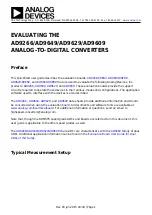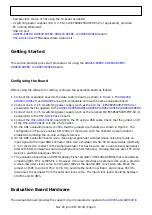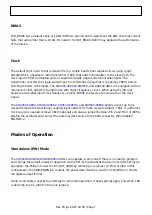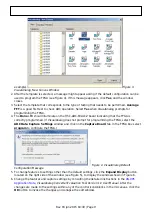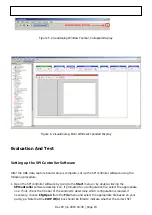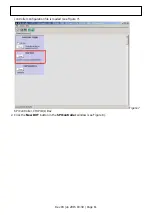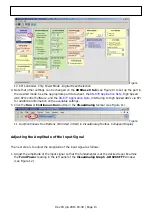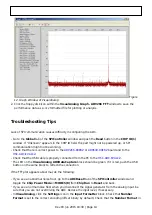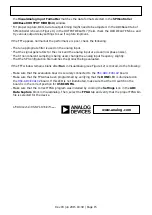
Rev 03 Jun 2015 18:39 | Page 4
their various modes and configurations. Figure 1 shows the typical bench characterization setup used
to evaluate ac performance. It is critical that the signal sources used for the analog input and clock
have very low phase noise (ideally ~100 fs rms jitter) to realize the optimum performance of the
signal chain. Proper filtering of the analog input signal to remove harmonics and lower the integrated
or broadband noise at the input is necessary to achieve the specified noise performance.
Schematics, layout files, bill of materials
for schematics and layout diagrams.
Power Supplies
This evaluation board comes with a wall-mountable switching power supply that provides a 6 V, 2 A
maximum output. Connect the supply to a 100 V ac to 240 V ac, 47 Hz to 63 Hz wall outlet. The
output from the supply is provided through a 2.1 mm inner diameter jack that connects to the printed
circuit board (PCB) at P101. The 6 V supply is fused and conditioned on the PCB before connecting to
the low dropout linear regulators that supply the proper bias to each of the various sections on the
board.
The evaluation board can be powered in a nondefault condition using external bench power supplies.
To do this, remove E101, E102, E103, E105, E107, E108, and E114 ferrite beads to disconnect the
bench supply traces from the on-board LDOs. Note that in some board configurations, some of these
ferrite beads might already be uninstalled.
P102 and P103 need to be installed to connect external bench supplies to the board and E109, E110,
E111, E112, and E113 need to be populated to connect P102 and P103 to the board power domains. A
1.8 V, 0.5 A supply is needed for P102 Pin 5 (1.8V_DUT_AVDD). The supplies for P103 Pin 1
(DUT_DRVDD) and P103 Pin3 (AUX_DVDD) can be any voltage from 1.8 V to 3.3 V. These two supplies
can be shared or separate but if they are separate, the voltages on each must match the other.
Two additional supplies, 3.3V_CLK and 3.3V_AMPVDD, are used to bias the optional input path
amplifiers, SPI buffers, and optional
clock chip. If used, each of these supplies need at least
a 0.5 A current capability.
Input Signals
When connecting the ADC clock and analog source, use clean signal generators with low phase noise,
such as the Rohde & Schwarz SMA, or an equivalent. Use a shielded, RG–58, 50 Ω coaxial cable
(optimally 1 m or shorter) for connecting to the evaluation board. Enter the desired frequency and
amplitude (see the Specifications section in the ADC data sheet). When connecting the analog input
source, use of a multipole, narrow-band band-pass filter with 50 Ω terminations is recommended.
Analog Devices uses band-pass filters from TTE and K&L Microwave, Inc. Connect the filters directly to
the evaluation board.
When an external clock source is used, it must be supplied with a clean signal generator, as
previously specified for the analog input signals. Analog Devices evaluation boards typically accept
~2.8 V p-p or 13 dBm sine wave input for the clock. If an external off-board clock source is used,

